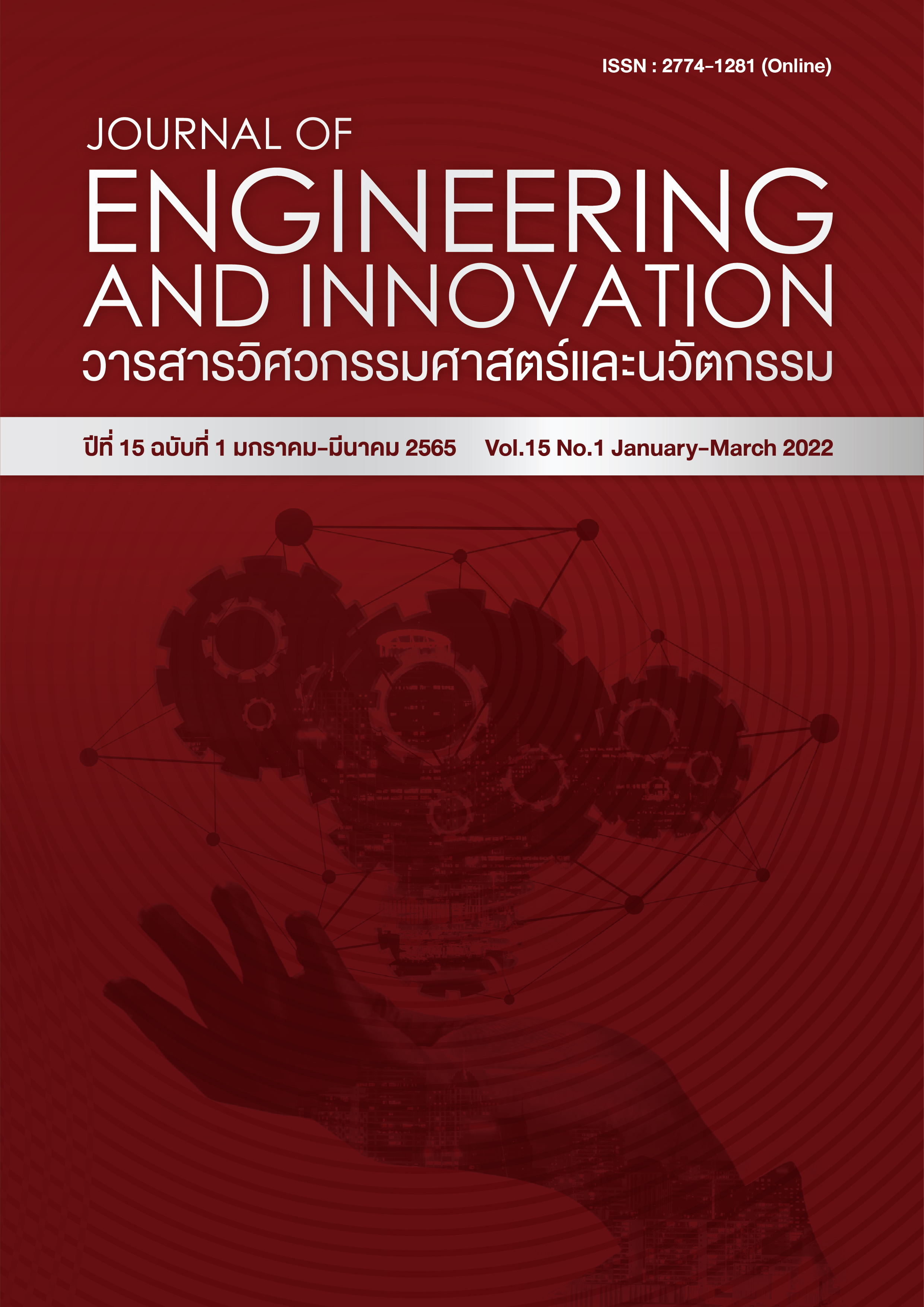Analysis of heat transfer of mobile calibration laboratory using 3-D finite element method
Main Article Content
Abstract
Nowadays, an internal environment of mobile calibration laboratory should be controlled which the internal environment impact factors are temperature, humidity and thermal for the highest efficiency of mobile calibration laboratory following the standard. Therefore, the temperature distribution monitoring of mobile calibration laboratory can improve the efficiency of internal system. So that, designing of the mobile calibration laboratory must immediately control thermal to maintain equilibrium.
This paper presents the second-order partial differential equation and the mathematical model of mobile calibration laboratories. The problem was solved by 3-D finite element method with backward time evaluation which developed and applied in MATLAB programming. The sample of insulator for simulation consist of polyurethane, polystyrene and glass wool. The simulation result shows the ability of insulation to thermal controlling of mobile calibration laboratories which polyurethane into thermal equilibrium of mobile calibration laboratory within 20 minutes at 25 °C. A polystyrene and glass wool into thermal equilibrium within 25 minutes and 30 minutes at 25 °C, respectively. Due to thermal diffusivity of polyurethane is lowest so that, the external thermal can be less transfer into internal laboratory than another insulator
Article Details
References
วริศรา ผานาค, “การออกแบบห้องปฏิบัติการสอบเทียบเคลื่อนที่ด้วยวิธีไฟไนท์อิลลิเมนต์ 3 มิติ” ปริญญาวิศวกรรมศาสตรมหาบัณฑิต สาขาวิชาวิศวกรรมเมคคาทรอนิกส์ มหาวิทยาลัยเทคโนโลยีสุรนารี ปีการศึกษา 2561.
V. Karius, and S. Yimvuthikul S, “Experiences with stationary and mobile calibration laboratories”, 1999 Eleventh International Symposium on High Voltage Engineering. Vol. 1, No. 1, pp. 189-192, 1999.
B. Bräutigam ,J. H. González , M. Schwerdt, and M. Bachmann, TerraSAR-X instrument calibration results and extension for TanDEMX. IEEE Trans. Geosci. Remote Sens, vol. 48, No. 2, pp. 702–715, 2010.
L. Xie , X. Yin, C. Lu, L. Yang, H. Zhao, and S. Li, “Hybrid analog–digital antenna array with built-in image injection calibration,” IEEE Trans. Antennas Propag. Vol. 62, No. 11, pp. 5513–5523, 2014.
L. Wu L, H. F. Leung, and A. Li, “A 4-element 60-GHz CMOS phasedarray receiver with beamforming calibration,” IEEE Trans. Circuits Syst. I, Reg. Papers, Vol. 64, No. 3, pp. 642–652, 2017.
I. Amornsawatwattana, and P. Poa-la-or, “Analysis of temperature in solar thermal by 3-D finite element method,” 5th International Electrical Engineering Congress, pp. 208-211, 2017.
M. Bhatti, “Advanced Topics in Finite Element Analysis of Structures,” John Wiley & Sons, USA, 2006.
N. Sukumar, B. Moran, and T. Belytschko, “The natural element method in solid mechanics,” Int. J. Numer. Methods Eng, Vol. 43, No. 5, pp. 839–887, 1998.
P. Kattan, MATLAB Guide to Finite Elements (2nd edition). Springer Berlin Heidelberg, USA, 2007.
S. Patcharee, A Design of Calibration Scheduling Methodology for Measuring Instrument. Management Engineering, Burapha University, 2559.
R. Lewis, P. Nithiarasu, and K. Seetharamu, “Fundamentals of the Finite Element Method for Heat and Fluid Flow” John Wiley & Sons, US, 2004.
S. Vacharakup, M. Peerasaksophol, T. Kulworawanichpong, and P. Pao-la-or, “Study of Natural Frequencies and Characteristics of Piezoelectric Transformers by Using 3-D Finite Element Method,” Applied Mechanics and Materials, pp. 61-66, 2012.
I. Amornsawatwattana, “Increasing the Efficiency of solar Thermal by 3-D Finite Element Method” The 12th Conference of Electrical Engineering Network 2020 (EENET 2020), Nakornnayok, Thailand, 26-28 August 2020, pp. 254-257, 2020.
S. Nattawut, and P. Padej, “Analysis of Insulation Performance in Various Types inside Freezer of the Refrigerator by 3-D Finite Element Method,” 14th Conference on Energy Network of Thailand (E-NETT), Rayong, Thailand, 19-15 June 2018, p.p. 55-58.
Australian urethane systems, Thermal insulation of rigid polyurethane foam. Australian urethane systems PTY limited. A.C.N. 000 168 874. Australia.
Engineering ToolBox. (2003). Convective Heat Transfer,URL:https://www.engineeringtoolbox.com/convective-heat-transfer- d_430.html, access on 1/04/2018.
W. Phanayingphaisal. “Reduce Maintenance Cost and Improve Availability of Calibration Tester in Calibration Room: A Case Study Measure Engineering Co., Ltd,” Industrial Management Engineering King Mongkut’s University of Technology North Bangkok. 2008.
R. K. Pal,G. Parveen,S. Shankar. “Effect of cellulose fibre based insulation on thermal performance of buildings,” Materialstoday: Proceedings Available online 22 March 2021.
ภาคภูมิ สุภาชาติ, อดิศักดิ์ นาถกรณกุล และณัฏฐ์ กาศยนันทน์ (2550). “การศึกษาพฤติกรรมการไหลของลมร้อนโดยการจำลองด้วย EasyFEM และเทคนิคชาร์โดว์กราฟ”, การประชุมวิชาการด้านพลังงานสิ่งแวดล้อมและวัสดุครั้งที่ 1.
ปิยกานต์ หาญสมัคร, เอกลักษณ์ พรมภักดี และกีรติ สุลักษณ์ (2557). “การทำนายพฤติกรรมการระบายอากาศและการกระจายอุณหภูมิ ภายในห้องโดยสารของรถโดยสารปรับอากาศ”, การประชุมวิชาการเครือข่ายวิศวกรรมเครื่องกลแห่งประเทศไทย. ครั้งที่ 28 15-17 ตุลาคม 2557 จังหวัดขอนแก่น.
การรับรองห้องปฏิบัติการ ข้อแนะนำประกอบการตรวจประเมินตาม มอก. 17025-2561. สำนักงานมาตรฐานผลิตภัณฑ์อุตสาหกรรมกระทรวงอุตสาหกรรม.

